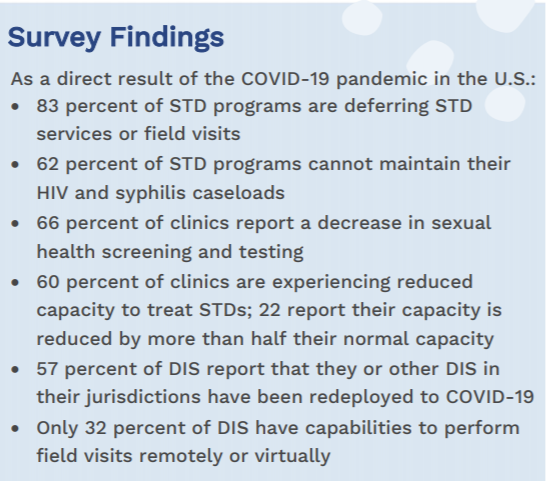COVID-19 and the State of the STD Field
A summary of findings from surveys of health department STD programs, DIS, and STD clinics in response to the COVID-19 pandemic.

View the full report
Introduction
Since the COVID-19 pandemic was declared a national emergency, the public health STD prevention field has redeployed staff and reoriented its activities to face the pandemic head on. The National Coalition of STD Directors (NCSD) is supporting the emergency response of our members—health department STD directors and their support staff across 50 states, seven large cities, and eight U.S. territories, disease intervention specialists (DIS), STD and sexual health clinics, and community-based partners across 50 states, seven large cities, and eight U.S. territories. We surveyed this membership regularly to determine the impact of COVID-19 response on the STD field.
Methods
In mid-March 2020, NCSD distributed SurveyMonkey assessments to STD program directors of the 65 jurisdictions directly funded by the CDC, our network of 1,100 disease intervention specialists, and our Clinic+ network of 500 STD and sexual health clinics. We asked recipients to take the SurveyMonkey assessment multiple times as their COVID-19 response evolved and local situations changed. Additionally, NCSD staff also performed direct outreach to collect more detailed information and to encourage members to complete the survey.
STD Program Survey
Sixty percent of the 65 jurisdictions responded to the survey, including low, medium, and high morbidity jurisdictions. All geographical areas are represented, as well as metropolitan areas. Only the most current survey responses for all jurisdictions are included in this summary to avoid data duplication.
STD Clinic Survey
To date, 64 responses have been collected representing over 230 clinics across the nation. Administrators frequently oversee multiple clinics.
Disease Intervention Specialist (DIS) Survey
To date, NCSD collected 108 responses representing more than 300 DIS across the country’s state and local health departments and districts.
Summary
Survey data and direct outreach to stakeholders make it clear that the public health emergency response to COVID-19 continues to cause mass scale disruptions to the STD prevention field and to STD clinical services in the U.S. Redeployment of STD program, DIS, and clinical staff have resulted in reduced services, clinical capacity, and STD outbreak control efforts. All jurisdictions voiced concern for the populations they serve and the significant impacts on STD screening, diagnoses, and treatment. STD programs are trying to determine ways to serve their vulnerable and marginalized populations while also responding to the COVID-19 pandemic. STD program, DIS, and clinical staff are eager to lend their expertise to the COVID-19 response; however, given the enormous scope and taxing nature of the work, STD programs, DIS, and STD and sexual health clinics cannot sustain their response without additional resources. With STDs already at all-time highs, COVID-19 response threatens the over-burdened and under-resourced STD prevention network in the U.S.
